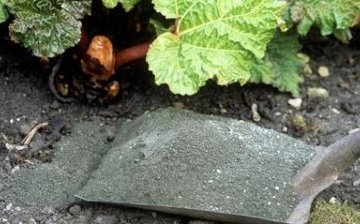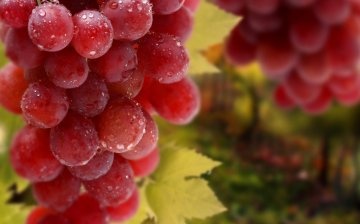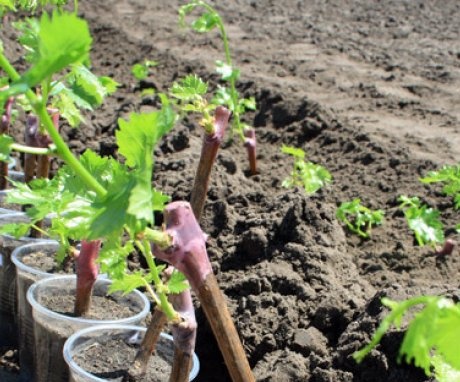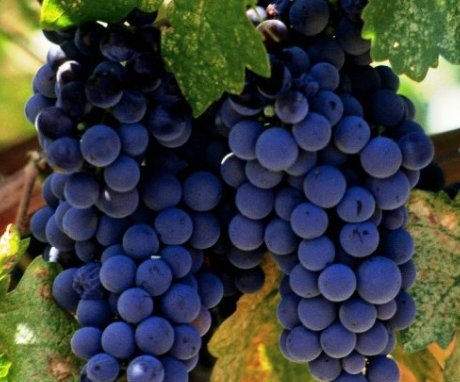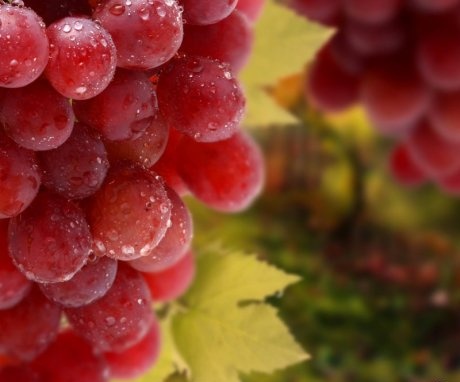All you need to know about growing grapes is proper planting and care
People grapes known since ancient times. Probably, this is one of the first berry crops "tamed" by man. It is possible that it was because of her that he began to lead a sedentary life, so it takes a long time to grow and then recycle grapes, for example, into wine.
Grapes have been used by humans for a long time. It contains over 140 biologically active substances. Its juice and fruits are rich in various vitamins and elements that are useful for our body. An essential oil is produced from the peel, and the peel of red grapes contains natural phenol-revaratrol, which prevents cancer. How to grow such a useful product in your own dacha?
Content:
- How to plant grapes?
- How to care for grapes?
- Watering and feeding grapes
- Tips for Beginner Winegrowers
How to plant grapes?
Pay attention to the appearance of the seedling. Inspect for mechanical damage, strange stains or drying out. If the seedling is healthy, then it will have three developed roots, and the height of the shoot will be up to fifty centimeters. Buy a seedling from the nursery - there is a quality guarantee.
It is better to buy seedlings in a container - such plants take root better.
And yet from cuttings grapes are much more interesting to grow! There are several ways to plant grape cuttings.
Planting with a long vine:
- First you need to prepare a pit with an irrigation pipe and drainage.
- A calcined and soaked vine about a meter in length is twisted into a spiral and laid in the ground, then it must be covered up to half with earth with fertilizers.
- Compact the planting site well and water liberally.
- After soaking up the water, fill the hole completely with earth. One bud should remain on the surface, sprinkle it with a small mound of earth.
- Such a planting helps the plant develop a powerful root system, and the bush begins to bear fruit faster.
Arc planting:
- If the variety does not take root well, then this particular planting must be used. Prepare the vine and wait for it to ripen. The vine should be about a meter long.
- Bend it and place it in the prepared hole.
- Fill the hole up to half with earth, tamp it, water it, then fill it completely.
- Jackdaws should be left along the entire length, since roots develop at all nodes.
- If you plant a bush with an arc up, then it will have two root systems, and the top will be common.
- Can also be planted downward in an arc. The consumption of cuttings, however, will increase.
How to care for grapes?
Main care for a grape bush in the first year is watering and tying. Do not overuse fertilizers with mineral elements at this very time. They will cause strong growth of young shoots, the vines will not ripen and may freeze during the colder months. At the end of summer, watering should be stopped. It is necessary to leave one stepson every twenty centimeters to create fruit arms, if the shoots began to grow too much. Rapid growth will stop naturally.
There are some operations that must be carried out when growing grapes:
- It is necessary to remove excess shoots at the very beginning of growth with a length of no more than 15 centimeters, the inflorescences should already be visible. With such a piece, you can correct the flaws of the pruning. You need to remove all weak shoots, shoots coming out of one eye. Basically, the second, third and fourth inflorescences on the shoot are broken out.
- The pinching procedure is performed if it is necessary to stop the rapid growth of the shoot. If the plant is not more than two years old, then such a procedure stimulates the development of stepsons in it. In old grape bushes that have already suffered from frost, pinching will cause new stepchildren to grow. Later, fruit arms will form from them. In the case of old grapes, the bushes are pinched after the appearance of 5 leaves.
- You need to pinch until the shoots become rough. You can pinch only after the brush, but not lower than eight leaves. These leaves will "feed" the brush, and then just that many buds will ripen by winter. Remove the growth point, and then wait a couple of weeks for the stepson to grow fifteen centimeters. Then pinch the stepson. In this case, the growth of the shoot will stop, and all the nutrients will go to maturation. harvestI. In addition, after pinching, the plant will become more resistant to frost.
- Do not pinch in drought.
- Grasshopping needs to be done in order to remove the excessive density of shoots and bunches. It should be remembered that the appearance of stepchildren is a normal reaction of plants that have started to grow strongly.
- On structures in the form of an arch, you can completely do without eliminating the stepsons - they do not really matter in this case. The stepson pinches after the second leaf, if the variety is resistant. Be aware that when the stepson is completely removed, the shoot will begin to branch strongly.
On annual and biennial shrubs, they are completely removed in order to grow good shoots (from which the sleeves are created). The grown shoots must be tied vertically, then they will grow better. On bushes that are already three years old, it is worth leaving a few bunches and growing four powerful shoots, and stepchildren should be removed, since they will only weaken the growth of the plant.
Chasing - removal of the very top of the green shoot.
It is carried out after the decay of strong growth. This procedure falls around the end of August. This technique will stop the excessive growth of shoots. Minting is not a necessary procedure. It is quite possible to do without it.
Watering and feeding grapes
Grapes - drought-resistant crop. In our country, it can be grown, content with only natural precipitation. But artificial irrigation is necessary to obtain large harvest... Without watering, it is difficult to grow the bushes, which are usually twined with gazebos, since it is moisture that helps the grapes grow. Also watering will help the bushes take root in the first year. Remember that a square centimeter of a grape leaf evaporates up to one and a half liters of moisture per day!
This culture is unpretentious, but the bushes in unprepared soil will grow more slowly, and will begin to bear fruit only after four years, and the yield will be very small.
For the bush to thrive, it needs nutrients from the soil.
The nutrition of grapes is mineral salts, the main elements necessary for the plant are potassium, iron, nitrogen and phosphorus, as well as some trace elements - boron, copper and molybdenum. If some element is absent in the soil, then another cannot replace it.
It is possible to compensate for the lack of nutrients by introducing organic (animal and bird manure, peat or compost) and mineral fertilizers... Organic fertilizers will help improve the structure of the soil, enrich the soil with beneficial bacteria.
Do not overdo it with mineral fertilizers, as their excessive amount in the soil can cause significant damage to the crop and cause chlorosis of the leaves.
You should not use compost made from scraps or remnants of vines for fertilization, this inhibits the growth of the plant, it will start to hurt.
Tips for Beginner Winegrowers
The first thing worth mentioning is the mistakes that beginners make when growing grapes. It is on these points that beginners mostly "stumble":
- Cuttings were stored incorrectly. This is probably the main mistake in the cultivation of grapes. The cuttings can get moldy in the bag, then initially the enterprise will be a failure.
- Haste to grow. Don't be in a hurry to grow cuttings in winter. If you grow a plant in the middle lane, then the optimal time to get cuttings after storage will be the beginning of March. It is best to get it in the second week. There is already enough lighting for chlorophyll to accumulate in the leaves. With early germination of cuttings, additional lighting will have to be installed.
- Soaking cuttings. Remember that the liquid must be either tap water, but settled, or melted snow water. Soak the cuttings in this liquid for about two days after storage. If the cuttings have lost a lot of liquid, then it is very difficult to root them in the future. To preserve the nutrients in the cuttings, the moisture temperature should be about two degrees. If the temperature is below zero, the vine will dry out.
- Root processing with growth stimulants. Use for processing Heteroauxin or Kornevin.
- How do I update slicers? Update the bottom cut by half a centimeter and cut it three centimeters above the first kidney from the top. Trim to green if the cut is not green.
- Waxing the top of the cutting. This process is carried out to avoid excessive evaporation of moisture from the upper kidney. We take an ordinary candle, melt the paraffin wax and dip the top of the cutting into this mass. The upper kidney does not need to be touched.
- Furrowing. It is necessary to make 3 longitudinal grooves along the cutting, stepping 5 centimeters up from the lower bud and drawing the grooves to the very bottom of the cutting.
- How much water to pour into the jar? When you process the cuttings with Kornevin, place them in a jar of water. If the water smells, then it needs to be changed and mucus removed from cuttings... You do not need to pour a lot of water into the jar, but you need to constantly monitor so that it does not evaporate.
- Do not rush to plant seedlings... When the first leaves appear, do not rush and plant the plants immediately. You need to wait for the roots to appear. If the shoot starts to grow too quickly, then pinch it over the third leaf.
- Planting a container for seedlings... After the appearance of even small roots, you need to plant the plant in the soil. The soil should not be saturated with nitrogen fertilizers.
More information can be found in the video.






